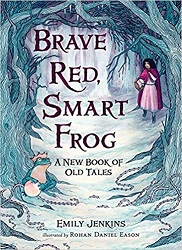
 Brave Red, Smart Frog
Brave Red, Smart FrogA New Book of Old Tales
Review posted May 1, 2018.
Candlewick Press, 2017. 94 pages.
Starred Review
2018 Sonderbooks Standout:
#10 Longer Children's Nonfiction
I have always loved fairy tales. My grandma owned several of the various-colored fairy tale books by Andrew Lang, and I remember sitting in her big comfy chair and reading them when I was quite young.
This is a 2017 book, but our library purchased it in 2018. When my hold came in, I saw the copyright and was going to turn it right back in – I’m reading for the Newbery, and I don’t have time for anything else. However, intrigued by the title and the look of the book, I opened to a random page. The tone and spirit of the tales captivated me quickly. I brought them home, figuring that reading one little story each day wouldn’t hurt anything.
And I really did get it read that way (which is surprising right there). At the end I cheated a little and read two stories in one night.
These are mostly Grimm tales, and I’m very familiar with all of them – but I love these fresh retellings. I like the new names she gives to characters, the explanations of their motivations, and that frozen and cold forest that shows up in almost all the tales. There’s even a place where a character in one story shows up in another! (Hint: There’s a huntsman in both “Snow White” and “Red Riding Hood.”)
Here’s an example paragraph right at the start that gives you the friendly and refreshing tone used throughout the book:
On one side of this frozen forest stood a castle. In it lived a queen who was unhappy. She was a warm person, a bright person. Her husband was chilly and dull. It had been a mistake to marry him. When their first and only daughter was born, the king named the baby Snow White. The queen would have preferred a name like Tulip or Sunshine.
An Author’s Note at the back gives her philosophy of retelling these stories. She wasn’t trying to be accurate to originals or entirely reinvent the tales.
What I’m doing instead is telling these stories largely faithfully, but without adhering to versions made famous by Charles Perrault, the Brothers Grimm, and others. I wrote them simply as I myself want to tell them, using the storytelling techniques I have at my disposal. After all, before people began writing them down, these tales were passed down orally. They changed a bit with each new teller. I wrote to bring out what’s most meaningful to me in the stories, and in that way I believe I am part of a tradition that goes back to the earliest tellers of these tales.
The result is delightful. These would be fun to read aloud at bedtime to a child or after lunch to a classroom.
Now, some kisses break enchantments.
And other kisses begin them.
You’re going to find both kinds of kisses in these tales.
